Lithium-ion batteries are the popular energy storage solution for various applications, from portable electronics to electric vehicles. Due to their high energy density, they are suitable for a variety of applications. In 2021, the global lithium-ion battery market was valued at approximately $38.92 billion and is expected to reach approximately $129.3 billion by 2027, with a compound annual growth rate (CAGR) of approximately 16.9%.
Despite their huge applications, their environmental impacts are concerning as they cause resource depletion, pollution, and safety risks.
The Environmental Impact of Lithium-ion Batteries
- Lithium-ion batteries are composed of toxic heavy metals, including lithium, cobalt, and nickel. These hazardous materials can contaminate the air, water, and soil when batteries are disposed of improperly, posing risks to human health and the environment. Approximately 97% of lithium-ion batteries worldwide end up in landfills, exacerbating the potential for toxic metals to leach into the surrounding environment, leading to groundwater pollution and habitat degradation with far-reaching consequences for ecosystems and wildlife.
- The mining of lithium has a large environmental footprint due to the huge requirement of water and chemicals.
Extracting lithium-rich brines from underground reservoirs requires substantial amounts of water, and the leftover brines often contain contaminants that disrupt local water ecosystems. Moreover, processing lithium into a usable form demands the use of chemicals, which, if mishandled, can result in air pollution and further environmental harm. - Deforestation is on the rise due to expanding mining activities to meet increasing supply demands of Lithium-ion batteries.
The destruction of forests results in habitat loss for various species and disrupts biodiversity, exacerbating climate change as forests play a crucial role in carbon sequestration, and their destruction releases stored carbon dioxide into the atmosphere, intensifying the greenhouse effect.
- The limited recycling capabilities of lithium-ion batteries pose environmental risks. With inadequate recycling infrastructure and techniques, used batteries are often disposed of improperly, leading to resource depletion and the accumulation of hazardous waste.
This emphasizes the need to explore and adopt alternative battery technologies that prioritize sustainability and minimize negative environmental impacts.
Advancing sustainable battery technologies that use safer and more abundant materials can contribute to a future with less dependence on finite resources, less pollution, and better waste management. The deployment of these alternative battery solutions can pave the way to a more sustainable and environmentally friendly energy storage landscape. In the following section, we list 5 sustainable battery technologies and their advantages.
5 Alternative Battery technologies
1. Solid-state batteries
Unlike conventional lithium-ion batteries, which use liquid electrolytes, solid-state batteries use solid electrolytes, which allow for higher energy density and better safety. These batteries are also less prone to leakage and thermal runaway, making them suitable for a variety of applications.
Solid-state batteries can use different electrode materials, such as lithium metal or lithium ion, resulting in higher energy storage capacity and longer cycle life. These batteries are expected to see significant growth in the coming years, with a projected compound annual growth rate (CAGR) of over 36.3% from 2021 to 2028. By 2028, the solid-state battery market is estimated to reach a value of around $5.31 billion.
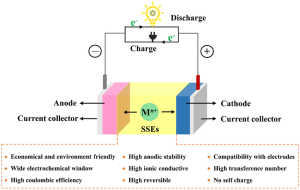 Image 1: Illustration of a solid battery cell. Source: ResearchGate
Image 1: Illustration of a solid battery cell. Source: ResearchGate
2. Sodium-ion batteries
Sodium-ion batteries are becoming increasingly popular as an alternative to lithium-ion batteries. They work on a similar principle to Li-ion cells and are expected to be at least 20% cheaper than Lithium-Iron-Phosphate due to the fact that sodium is more abundant than Lithium.
These batteries are anticipated to witness substantial market growth, with a projected CAGR of over 11.45% by 2028. The sodium-ion battery market is expected to reach a value of approximately $172.12 million by 2028.
Although sodium-ion batteries currently have lower energy density compared to lithium-ion batteries, ongoing research is focused on improving their performance. The sodium-ion batteries are versatile in that they are suitable for a variety of applications, especially where high energy density is not a primary concern.
These batteries hold promise for grid-level energy storage, renewable energy integration, and other stationary applications where cost efficiency and long cycle life are key factors. In addition, sodium-ion batteries could be used in portable electronic devices and low-power appliances, providing an environmentally friendly alternative with less dependence on scarce resources.
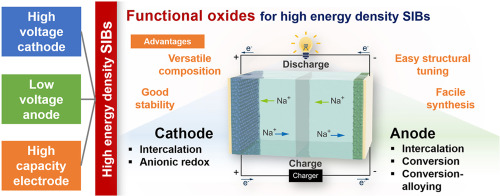 Image 2: Movement of Sodium-ion between cathode and anode as well as advantages of it. Source: ScienceDirect
Image 2: Movement of Sodium-ion between cathode and anode as well as advantages of it. Source: ScienceDirect
3. Flow batteries
Flow batteries offer a unique approach to energy storage by separating energy and power components. Here, energy is stored in liquid electrolytes contained in external tanks, while power is generated by flowing the electrolytes through the battery stack.
They are suited for large-scale and stationary energy-storage applications, such as grid-level energy storage, as they can provide long-duration storage. Also, this battery market is forecasted to grow at a CAGR of around 22.8% from 2023 to 2028. By 2028, the global flow battery market is expected to be worth approximately $805 million.
Liquid electrolytes used in flow batteries are, vanadium, zinc-bromine, and organic compounds. These batteries also offer advantages such as cost-effectiveness and high energy density, making them suitable for medium to large-scale energy storage projects.
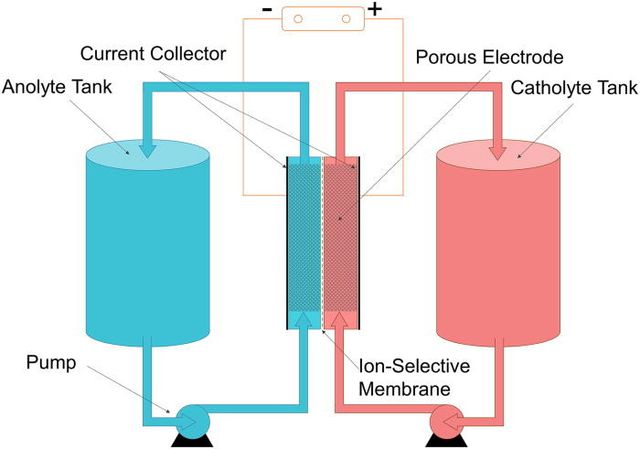 Image 3: A typical flow battery consists of two tanks of liquids which are pumped past a membrane held between two electrodes. Source: Wikipedia
Image 3: A typical flow battery consists of two tanks of liquids which are pumped past a membrane held between two electrodes. Source: Wikipedia
4. Supercapacitors
Supercapacitors, also referred to as ultracapacitors or electric double-layer capacitors (EDLCs), stand out from traditional batteries due to their unique characteristics and rapid charge and discharge capabilities. Unlike conventional batteries that store energy through chemical reactions, supercapacitors store electrical energy electrostatically. This means that they can charge and discharge almost instantaneously, making them ideal for applications that require rapid power delivery.
Also, they have a high-power density, long cycle life, and excellent performance over a wide temperature range. They are suitable for applications that need frequent power bursts rather than long-term energy storage. These batteries are experiencing steady growth, with a projected CAGR of over 30.45% from 2023 to 2030. By 2030, the global supercapacitor market is estimated to reach a value of around $15.74 billion.
Supercapacitors have a wide range of applications in everyday life. They are used in emergency power systems that provide instantaneous power to critical infrastructure such as telecommunications, data centers, and emergency lighting during power outages. They are also used in renewable energy systems, especially in conjunction with solar cells or wind turbines, to compensate for fluctuations in power generation and ensure a stable power supply.
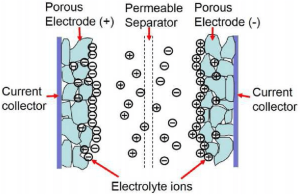
Image 4: Supercapacitor cross-section. Source: ResearchGate
5. Metal-air batteries
Metal-air batteries have attracted attention because of their high energy density potential. These batteries rely on the chemical reaction between a metal anode and oxygen in the air, producing electrical energy.
Metal-air batteries are lightweight, offer high energy storage capacity, and have the advantage of being of abundant and non-toxic materials. Yet, their limited lifetime and sensitivity to water and carbon dioxide present challenges that researchers are addressing. This battery market is poised to grow at a CAGR of over 13.73% from 2022 to 2028. By 2028, the global metal-air battery market is projected to reach a value of approximately $1,173 million.
They are appealing for a variety of reasons. Due to their lightweight design, they are a preferred choice for weight-reduction applications, such as electric vehicles and portable electronic devices. Additionally, these batteries boast a high energy storage capacity, enabling them to store a substantial amount of energy compactly, making them ideal for long-lasting and powerful energy sources.
One of the key advantages of metal-air batteries is their use of abundant and non-toxic materials. The common metal-air batteries such as Zinc-air and aluminum-air batteries use readily available and widely distributed metals, ensuring a stable supply chain.
Image 5: Schematic diagrams of the operation mechanism of a metal–air battery (MAB), along with the oxygen reduction reaction on the cathode in aqueous and non-aqueous electrolytes. Source: ResearchGate
Each of these 5 alternative battery technologies overcomes the environmental issues associated with Li-ion batteries. Adopting these alternative technologies will play a critical role in mitigating environmental risks and building a more resilient and sustainable future for generations to come. Ongoing research and development of sustainable battery technologies have the potential to significantly reduce the environmental impact of energy storage systems. Continued research and development of these environmentally friendly alternatives can make progress toward a more sustainable and greener future.
If you enjoyed reading our articles, please support us by buying our geeky merchandise on Instagram. Alternatively, you could buy us a coffee or follow us on Facebook, Twitter, Pinterest, or Medium.



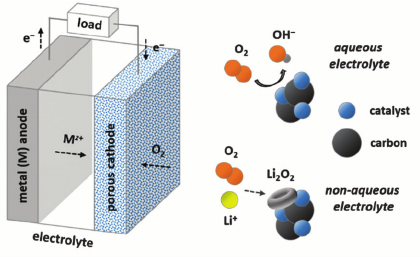
1 comment
[…] The viability of fossil fuels is not only diminishing; some of them also contribute to environmental pollution. Nickel hydrogen batteries are a beneficial alternative that could revolutionise power sources. It minimises pollution with low expenditures and enhances performance as a green option. Ultimately, it would be a step towards a more sustainable and efficient future energy system. […]